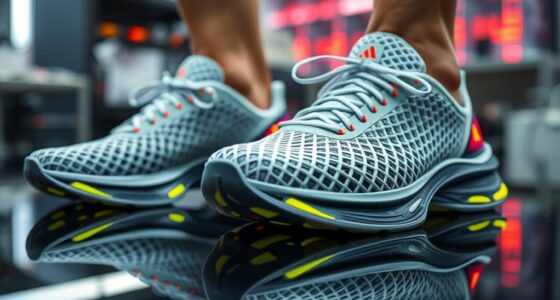Micro-dosing altitude involves brief, controlled exposure to hypoxic environments to boost your endurance, recovery, and overall performance safely. By stimulating your body’s natural adaptation processes, you can enhance oxygen delivery and stamina without the risks of prolonged high-altitude stays or costly gear. It’s a smart, personalized approach that fits into your training routine, offering sustainable performance gains. To discover how this cutting-edge method can elevate your limits, keep exploring the possibilities.
Key Takeaways
- Micro-dosing altitude stimulates natural physiological adaptations, enhancing oxygen efficiency and endurance without the risks of prolonged high-altitude exposure.
- Tiny doses of hypoxia trigger increased red blood cell production, improving stamina and recovery for athletes.
- Customized micro-dosing methods like hypoxia masks and altitude tents allow safe, targeted altitude training tailored to individual goals.
- Integrating micro-dosing altitude with training amplifies performance gains while minimizing altitude sickness symptoms.
- Ongoing scientific research suggests micro-dosing altitude is a promising, accessible frontier for sustainable endurance training advancements.

Have you ever wondered how tiny doses of altitude exposure can boost your performance and well-being? That’s the core idea behind micro-dosing altitude, a revolutionary approach in endurance training. Instead of spending weeks at high elevations or using costly equipment, you can harness the benefits of hypoxic training through small, controlled doses of altitude exposure. This method aims to stimulate altitude adaptation, where your body learns to function efficiently with less oxygen, ultimately improving endurance and recovery. By gradually introducing these micro-doses, you avoid the stress and fatigue associated with full-altitude training, making it a more sustainable and accessible option for athletes and fitness enthusiasts alike.
Tiny altitude doses can boost endurance and recovery safely and effectively.
When you incorporate micro-dosing altitude into your routine, you’re fundamentally triggering your body’s natural adaptive mechanisms. During hypoxic training, your body responds by increasing red blood cell production, enhancing oxygen delivery to your muscles, and boosting overall stamina. These subtle altitude exposures act as a catalyst for altitude adaptation, training your physiology to perform better under oxygen-deprived conditions. Over time, this improves your ability to sustain effort during competition or intense workouts without the need for prolonged stays at high elevations. The key is consistency; even brief, regular sessions can accumulate significant benefits, making it easier to fit into your busy schedule.
This approach also minimizes common altitude sickness symptoms, which often occur during traditional high-altitude training. Since the doses are small, your body has a chance to adapt gradually, reducing the risk of fatigue, headache, or nausea. Plus, micro-dosing altitude can be tailored to fit your specific goals—whether you’re aiming to break personal records, enhance recovery, or simply boost your overall health. You can achieve these benefits using various methods, like simulated hypoxia masks, altitude tents, or controlled breathing exercises, all designed to create a hypoxic environment in a manageable, safe way.
The science behind micro-dosing altitude is still evolving, but early results suggest it offers a promising shortcut to altitude adaptation. It allows you to tap into the advantages of altitude training without the logistical hurdles or health risks associated with traditional methods. As you experiment with micro-dosing, you’ll likely notice improvements in your endurance, mental clarity, and recovery times. It’s a forward-thinking approach that aligns with modern training principles—smart, efficient, and personalized. In effect, micro-dosing altitude could be your secret weapon for pushing limits and achieving new performance heights with just tiny doses of altitude exposure.
Additionally, emerging research indicates that combining micro-dosing altitude with specific training programs can amplify overall athletic performance and recovery.
Frequently Asked Questions
How Quickly Can I Expect Results From Micro-Dosing Altitude?
You might start noticing altitude adaptation benefits within a few weeks of micro-dosing, but significant results typically take around 4 to 8 weeks, depending on your training timeline and consistency. Keep in mind, gradual exposure helps your body adapt better, so patience is key. With regular micro-dosing, you’ll likely see improved endurance and oxygen efficiency as your body adjusts to the altitude effects over time.
Are There Any Age Restrictions for Micro-Dosing Altitude Training?
When considering age restrictions for micro-dosing altitude training, safety is your top priority. Generally, younger individuals and older adults should consult a healthcare professional before starting, as safety considerations vary based on age and health conditions. While there aren’t strict age limits, it is crucial to assess your personal health and get medical advice to ensure safe and effective training, especially for those with underlying health issues or advanced age.
What Are the Potential Long-Term Health Effects?
You wonder about the long-term health effects of micro-dosing altitude training. While this approach may promote physiological adaptation and improve endurance, it could also lead to chronic hypoxia if not properly monitored. Potential risks include cardiovascular strain or respiratory issues over time. It is crucial to consult with healthcare professionals and monitor your response carefully, ensuring the benefits outweigh any possible adverse effects from sustained altitude exposure.
Can Micro-Dosing Altitude Replace Traditional High-Altitude Training?
Like a gentle breeze replacing a storm, micro-dosing altitude might seem promising, but it can’t fully match traditional high-altitude training. You gain altitude benefits and training adaptations through sustained exposure, which micro-dosing can’t replicate. While it offers a convenient alternative, it may not produce the same level of endurance gains or physiological changes. So, it’s unlikely to completely replace the proven effectiveness of full-altitude training.
What Equipment Is Required for Safe Micro-Dosing Altitude Sessions?
To guarantee safe micro-dosing altitude sessions, you need essential equipment like safety gear—such as a mask or nasal cannula—and reliable monitoring devices to track oxygen levels and heart rate. These tools help you maintain proper altitude exposure and prevent health risks. Always check that your equipment is properly calibrated and comfortable, and consult with a professional to tailor your setup for safe, effective micro-dosing altitude training.
Conclusion
So, next time you’re craving a quick boost, maybe skip the long climbs and try micro-dosing altitude instead. Who knew that tiny doses could level up your endurance—without the hassle of high-altitude hikes? Ironically, it’s almost too good to be true: boosting performance with just a pinch. Just remember, while small doses might pack a punch, they probably won’t turn you into an endurance legend overnight. But hey, it’s worth a shot!










